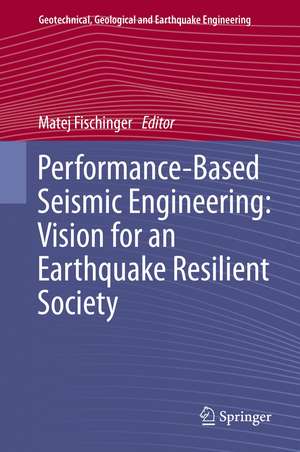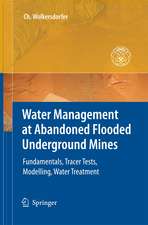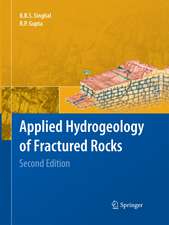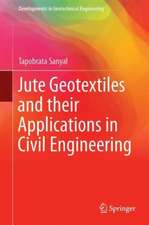Performance-Based Seismic Engineering: Vision for an Earthquake Resilient Society: Geotechnical, Geological and Earthquake Engineering, cartea 32
Editat de Matej Fischingeren Limba Engleză Hardback – 30 iul 2014
The book aims to provide essential guidelines for researchers, professionals and students in the field of earthquake engineering. It will also be of particular interest for all those working at insurance companies, governmental, civil protection and emergency management agencies that are responsible for assessing and planning community resilience.
The introductory chapter of the book is based on the keynote presentation given at the workshop by the late Professor Helmut Krawinkler. As such, the book includes Helmut’s last and priceless address to the engineering community, together with his vision and advice for the future development of performance-based design, earthquake engineering and seismic risk management.
| Toate formatele și edițiile | Preț | Express |
|---|---|---|
| Paperback (1) | 803.52 lei 38-44 zile | |
| SPRINGER NETHERLANDS – 27 sep 2016 | 803.52 lei 38-44 zile | |
| Hardback (1) | 961.86 lei 6-8 săpt. | |
| SPRINGER NETHERLANDS – 30 iul 2014 | 961.86 lei 6-8 săpt. |
Din seria Geotechnical, Geological and Earthquake Engineering
- 15%
 Preț: 665.73 lei
Preț: 665.73 lei - 18%
 Preț: 1405.90 lei
Preț: 1405.90 lei - 15%
 Preț: 717.59 lei
Preț: 717.59 lei - 18%
 Preț: 959.19 lei
Preț: 959.19 lei - 15%
 Preț: 656.43 lei
Preț: 656.43 lei - 18%
 Preț: 1944.11 lei
Preț: 1944.11 lei -
 Preț: 392.60 lei
Preț: 392.60 lei - 18%
 Preț: 954.62 lei
Preț: 954.62 lei - 18%
 Preț: 954.45 lei
Preț: 954.45 lei - 15%
 Preț: 638.24 lei
Preț: 638.24 lei - 18%
 Preț: 954.45 lei
Preț: 954.45 lei - 15%
 Preț: 640.24 lei
Preț: 640.24 lei - 20%
 Preț: 572.65 lei
Preț: 572.65 lei - 24%
 Preț: 805.40 lei
Preț: 805.40 lei - 20%
 Preț: 602.78 lei
Preț: 602.78 lei - 15%
 Preț: 639.08 lei
Preț: 639.08 lei - 18%
 Preț: 1242.83 lei
Preț: 1242.83 lei - 15%
 Preț: 639.73 lei
Preț: 639.73 lei - 15%
 Preț: 637.46 lei
Preț: 637.46 lei - 18%
 Preț: 1222.01 lei
Preț: 1222.01 lei - 18%
 Preț: 967.08 lei
Preț: 967.08 lei - 18%
 Preț: 959.98 lei
Preț: 959.98 lei - 15%
 Preț: 658.88 lei
Preț: 658.88 lei - 18%
 Preț: 969.44 lei
Preț: 969.44 lei - 15%
 Preț: 653.79 lei
Preț: 653.79 lei - 15%
 Preț: 657.73 lei
Preț: 657.73 lei - 18%
 Preț: 961.55 lei
Preț: 961.55 lei - 15%
 Preț: 652.49 lei
Preț: 652.49 lei - 15%
 Preț: 649.06 lei
Preț: 649.06 lei -
 Preț: 450.02 lei
Preț: 450.02 lei - 18%
 Preț: 967.22 lei
Preț: 967.22 lei - 18%
 Preț: 1117.99 lei
Preț: 1117.99 lei - 15%
 Preț: 656.58 lei
Preț: 656.58 lei
Preț: 961.86 lei
Preț vechi: 1173.01 lei
-18% Nou
Puncte Express: 1443
Preț estimativ în valută:
184.08€ • 191.47$ • 151.96£
184.08€ • 191.47$ • 151.96£
Carte tipărită la comandă
Livrare economică 15-29 aprilie
Preluare comenzi: 021 569.72.76
Specificații
ISBN-13: 9789401788748
ISBN-10: 940178874X
Pagini: 532
Ilustrații: XXIII, 505 p. 264 illus., 175 illus. in color.
Dimensiuni: 155 x 235 x 38 mm
Greutate: 0.92 kg
Ediția:2014
Editura: SPRINGER NETHERLANDS
Colecția Springer
Seria Geotechnical, Geological and Earthquake Engineering
Locul publicării:Dordrecht, Netherlands
ISBN-10: 940178874X
Pagini: 532
Ilustrații: XXIII, 505 p. 264 illus., 175 illus. in color.
Dimensiuni: 155 x 235 x 38 mm
Greutate: 0.92 kg
Ediția:2014
Editura: SPRINGER NETHERLANDS
Colecția Springer
Seria Geotechnical, Geological and Earthquake Engineering
Locul publicării:Dordrecht, Netherlands
Public țintă
ResearchCuprins
Part I: Helmut's Vision.- Challenges Towards Achieving Earthquake Resilience through Performance-Based Earthquake Engineering.- Part II: Global Vision.- Engineering Challenges on the Way to Resilient Structures and Communities.- Toward the Bled Workshop in Future.- Global Challenges and the Role of Civil Engineering.- Earthquake-Resistant Bridges of the Future with Advanced Materials.- Inelastic Shear Response and Strengthening of RC Bridge Hollow Box Piers.- Developments in Codifying Direct Displacement-Based Seismic Design.- Part III: New Vision after Recent Earthquakes.- A Lesson from the 2011 Tohoku Earthquake – The necessity for collaboration and dialog among natural scientists, engineers, social scientists, government agencies and the general public.- Lessons Learned from the 2010 Haiti Earthquake for Performance-Based Design.- L'Aquila Earthquake: A Wake-Up Call For European Research and Codes.- Lessons from the 2010 Chile earthquake for performance based design and code development.- Performance-Based Issues from the 22 February 2011 Christchurch Earthquake.- Part IV: Vision in Japan and Asia (Coordinated and edited by Masayoshi Nakashima).- Seismic Performance of a Bridge Column Based on E-Defense Shake-Table Excitations.- Development of Building Monitoring System to Verify the Capacity Spectrum Method.- Evaluation on ultimate flexural deformability of reinforced concrete columns with wing walls.- Seismic Performance and Reinforcement of Japanese High-Rise Buildings Facing Subduction Earthquakes: E-Defense Shake Table Tests.- Pseudo-dynamic Performance Evaluation of Full Scale Seismic Steel Braced Frames Using Buckling-Restrained and In-plane Buckling Braces.- Theory and Applications of the 3-DOF Modal System for PBSE of Asymmetrical Buildings.- Part V: Vision in Europe (Coordinated and edited by Peter Fajfar).- Pushover-based analysis in performance-based seismic engineering – A view from Europe.- Challenges and problems in performance-baseddesign of tall buildings.- Performance Based Earthquake-Resistant Design: Migrating Towards Nonlinear Models and Probabilistic Framework.- Seismic fragility of RC buildings designed to Eurocodes 2 and 8.- Performance-Based Assessment of Existing Buildings in Europe: Problems and Perspectives.- Inelastic Shear Response of RC Walls – A Challenge in Performance Based Design and Assessment.- Masonry buildings, seismic performance and Eurocodes.- Part VI : Vision in Americas (Coordinated and edited by Jack Moehle and Andrei Reinhorn).- Performance-based earthquake engineering in the U.S.A case study for tall buildings.- Consideration of Resilience of Communities in Structural Design.- Ground motion selection for performance-based engineering: Effect of target spectrum and conditioning period.- Reliability Considerations in the Seismic Capacity Design Requirements for Force-Controlled Components.- Reassessing ACI 318 Shear Wall Provisions Based on Recent Earthquake and Test Observations.- Collapse Probability of Existing Concrete Buildings: The Evolution of Seismic Rehabilitation in North America.- Earthquake-Resilient Communities: A Look from Mexico.
Textul de pe ultima copertă
The Bled workshops have traditionally produced reference documents providing visions for the future development of earthquake engineering as foreseen by leading researchers in the field. The participants of the 2011 workshop built on the tradition of these events initiated by Professors Fajfar and Krawinkler to honor their important research contributions, and have now produced a book providing answers to crucial questions in today’s earthquake engineering: “What visible changes in the design practice have been brought about by performance-based seismic engineering? What are the critical needs for future advances? What actions should be taken to respond to those needs?” The key answer is that research interests should go beyond the narrow technical aspects and that the seismic resilience of society as a whole should become an essential part of the planning and design process.
The book aims to provide essential guidelines for researchers, professionals and students in the field of earthquake engineering. It will also be of particular interest for all those working at insurance companies, governmental, civil protection and emergency management agencies who are responsible for assessing and planning community resilience.
The introductory chapter of the book is based on the keynote presentation given at the workshop by the late Professor Helmut Krawinkler. As such, the book includes Helmut’s last and priceless address to the engineering community, together with his vision and advice for the future development of performance-based design, earthquake engineering and seismic risk management.
The book aims to provide essential guidelines for researchers, professionals and students in the field of earthquake engineering. It will also be of particular interest for all those working at insurance companies, governmental, civil protection and emergency management agencies who are responsible for assessing and planning community resilience.
The introductory chapter of the book is based on the keynote presentation given at the workshop by the late Professor Helmut Krawinkler. As such, the book includes Helmut’s last and priceless address to the engineering community, together with his vision and advice for the future development of performance-based design, earthquake engineering and seismic risk management.
Caracteristici
Part of a series of popular books very frequently used in citation and research proposals The vision of highly qualified authors representing the very top in Earthquake Engineering The support and the assistance in distribution by major research centres in Earthquake Engineering






















